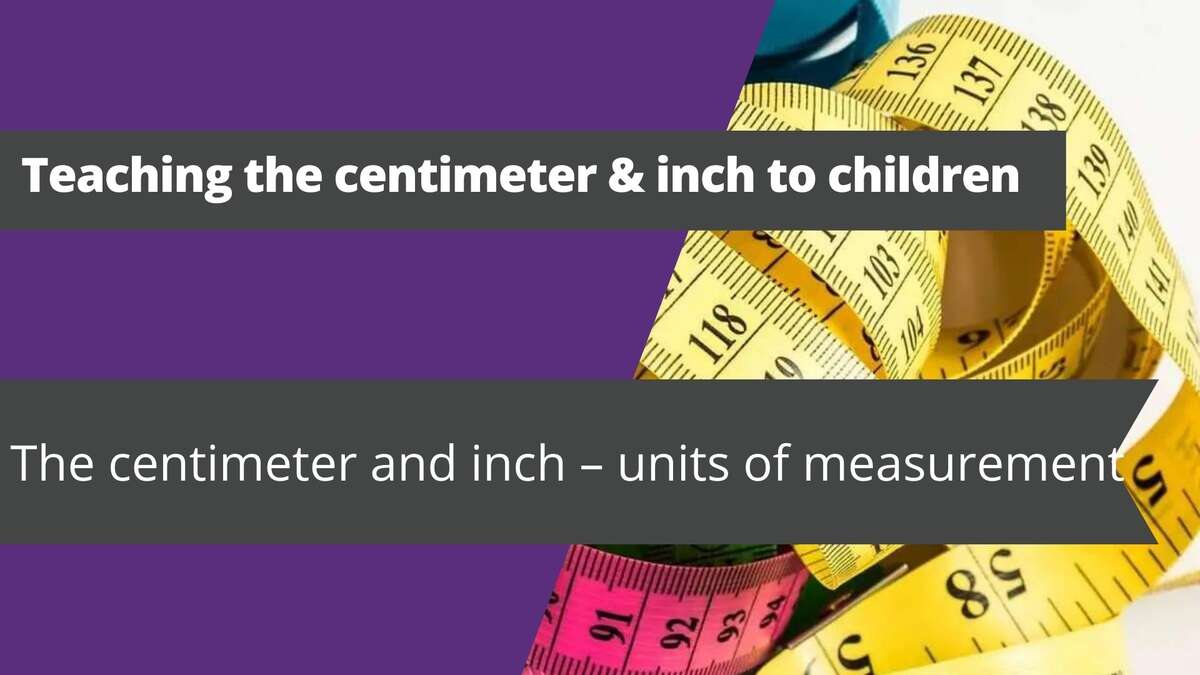Teaching the centimeter & inch to children

Teaching the centimeter & inch to children is not an easy task. It is a totally different thing teaching children from teaching adults. Children usually need more explanation, examples and a lot of patience – this is not a secret. But what are specific tips to teach them the centimeter & inch?
The process of teaching the centimeter and inch to children can be quite difficult both for parents and teachers, especially teachers who are just starting their careers. And that’s why we want to make it easier. Regardless if you are a parent or a teacher, you will find here some tips on how to teach the centimeters and inches to children in a clear, interesting way.
So before you start teaching centimeters and inches to children (with the success of course!), let us teach you a little about teaching math to young people.
The centimeter and inch – units of measurement
When it comes to teaching, regardless of the topic and the audience, the first thing will always be telling the basics. And in the case of the centimeter and inch, it should look the same.
Start with the basics – it means to start with teaching children what is the centimeter and inch, what the differences between them are, what the examples of their use are.
Of course, you need to remember that you are going to teach children, so you do not need to show them difficult definitions or tell them about the history of these units. Children will not be interested in it, and even if they will listen to you, they will forget about it a second after you stop talking.
This one rule may be helpful for you to teach the centimeter & inch to children – tell them only this information which you want to hear if you were in their place. And don’t forget – tell them the basics in a way as interesting as possible, because children get bored easily.
So what do we recommend to tell children about centimeters and inches as an introduction?
- The centimeters and inches are units of length. How to define length? You can use as an example the length of your hand from shoulder to top of your fingers.
- They are quite small units. To make this issue clear, you can explain that that's why they are not used to measure long distances, for instance, from home to school. In turn, they will be perfect to measure the length of a book.
- The centimeter and an inch are different. You can explain it using a comparison to family ties – the centimeter and inch are not twins, but only siblings.
Of course, you can tell children a lot more. It depends on you. We showed you examples with only basic information. But remember to adjust the information to the age of the children that you are going to teach or the time in which you will have to communicate knowledge.
We showed you not only examples of information which you can tell the children at the beginning of teaching about centimeters and inches, but also our propositions to explain the aforementioned issues. But of course, you can explain each of these issues in your own way. Your only limit is your imagination.
The cm & inch – values
Besides the theory of the centimeter and inch, you need to teach children about the values of these units. The theory is needed to understand this topic better, but the values are a must to go one step further – it means to the centimeters and inches conversion.
So first you need to tell the children the values of the centimeter and inch. They look as follows:
- 1 inch = 2.54 centimeters;
- 1 centimeter = 0.393700787 inches.
As you can see, the second result can be problematic to remember for children. That’s why we recommend using an approximation. Then the values will look like this:
- 1 inch = 2.54 centimeters;
- 1 centimeter = 0.39 inches.
If you are going to teach young children and want to make the topic of centimeters and inches as easy as possible, you can use another pair of approximate results. Have a look:
- 1 inch = 2.5 centimeters;
- 1 centimeter = 0.4 inches.
The last pair of values will be the easiest to remember and then to calculate too. Of course, the results calculated with their use will be approximated, but it will allow the children to try and understand the rules of conversions. Then the calculations with the accurate pair of values will be so much easier.
Conversion of the cm and inch – formulas and rules
After teaching children the values of the centimeter and inch, the time for teaching formulas of conversion comes. In this case, it is needed to show them as clearly as possible and then show also step-by-step examples. Be prepared for a lot of questions!
The conversion formulas vary depending on the type of conversion (inch to cm or cm to inch). See these 2 types one by one.
The inch to cm conversion formula:
As a conversion rate, you can put any given in the previous part of the article. It can be exactly 2.54 centimeters or approximately 2.5 centimeters.
We will use the exact conversion rate to show you the equation. Have a look:
And then, the cm to inch conversion formula:
And as in the previous example, you can use the value of the conversion rate matched to the group or child that you are going to teach and them or her/his advancement. Down below you can see the formula with the approximate conversion rate to 2 decimal places:
As you can see, in brackets we gave additional annotations. They may help children with understanding how the process of conversion, both inch to cm and cm to inch, looks.
Examples of the cm and inch conversion
And now the most important part of teaching the centimeter & inch to children – examples. Why is it so important? It is commonly known that the best way to learn is to practice. And examples showing step by step are the base of practice. Then children can follow the steps from examples and make their own calculations correctly.
We are going to show you 3 examples per conversion. It means 3 per inch to cm conversion and 3 per cm to inch conversion. All with the use of previously given formulas with inserted conversion rates.
So first, the inch to cm conversion. We are going to calculate 2, 5 and 10 inches to centimeters.
Conversion of 2 inches to centimeters step by step:
- Remind a formula: The number of inches (which you currently have) * 2.54 = the number of centimeters (equal to the previous number of inches)
- Put the number of inches, in this case 2, into the formula. It will look like this: 2 * 2.54 = the number of centimeters (equal to the previous number of inches)
- Multiply 2 by 2.54 and get the result: 2 * 2.54 = 5.08
So 2 inches are equal to 5.08 centimeters.
Now another example. Convert 5 inches to centimeters. This time in a shorter version:
5 * 2.54 = 12.7
So 5 inches are 12.7 centimeters.
And the last example of this type of conversion. Now convert 10 inches to centimeters. It looks like follows:
10 * 2.54 = 25.4
So 10 inches is equal to 25.4 centimeters.
And now see the reverse calculation. Convert centimeters to inches – also 2, 5 and 10.
The first example we will show you with a full explanation. So conversion of 2 centimeters to inches will look like this:
- Remind a formula: The number of centimeters (which you currently have) * 0.39 = the number of inches (equal to the previous number of centimeters)
- Put the number of centimeters, in this case 2, into the formula. It will look like this:2 * 0.39 = the number of inches (equal to the previous number of centimeters)
- Multiply 2 by 0.39 and get the result: 2 * 0.39 = 0.78
So 2 centimeters are 0.78 inches. Let’s see another example.
Convert 5 centimeters to inches this time:
5 * 0.39 = 1.95
It means 5 centimeters is equal to 1.95 inches.
And the last calculation. Convert 10 centimeters to inches now:
10 * 0.39 = 3.9
So 10 centimeters are 3.9 inches.
The centimeter & inch worksheet
The examples shown step by step are so important in the process of teaching children, but it is not enough. After seeing examples, children should try making conversions on their own. And the perfect way to give children a chance to convert on their own is using the centimeter and inch worksheet.
There are 3 ways to get the worksheets for your students or your child. First, the worksheet with centimeters and inches exercises you can download from the Internet for free. Second, if you want to get a more elaborated worksheet, you can also buy it. Worksheets are available individually and also in a bigger package or even a book (or e-book, depending on the form which you need or prefer). And third, you can make a worksheet on your own.
How to make your own worksheet? After all, you need exercises. They could be not only conversion tasks. You can combine them with quizzes, matching exercises or filling gaps exercises. Be creative. Your students or your child will appreciate it. And, more importantly, they will learn more likely with better effects.
The worksheet you can create in programs like word or google docs. If you want your worksheet to look more professional, you can also use graphics programs. There is also a third way – you can just write the exercises on a piece of paper.
Other methods to teach the centimeter & inch to children
We showed you how to teach the centimeter & inch to children step by step. But we can say it is a basic method. As you may know, children like to learn in non-standard ways. So what can you do to more interest children with the topic which you are going to discuss?
First, you don’t have to teach children in a class or room, using only a board or even worksheets. You can also use other activities to communicate knowledge. One of the best ways to teach children is teaching through playing. You can figure out your own games or board games, or look for inspiration on the Internet. It is also possible to buy ready-to-use books with math game propositions.
What more can you do to interest children with the centimeter and inch? The perfect choice is videos. Just review YouTube or websites with video content. Depending on the age of children which you are going to teach, you can pick more fun videos or videos with more examples shown step by step.
We hope that now teaching the centimeter & inch to children will be easier for you. Enjoy our methods, inspire them and create your own ways to effectively communicate knowledge.
Do you want to enrich your lessons? Check our articles dedicated to the centimeter and inch, for instance, about which is bigger – 1 cm or 1 inch. Show children interesting tidbits and prepare additional worksheets!









